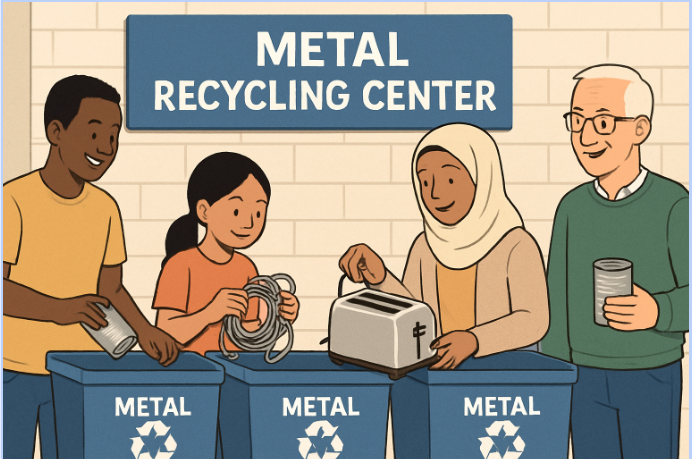Key Takeaways:
- Scrap metal recycling significantly boosts local economies by creating jobs and supporting businesses.
- Environmental benefits include reduced landfill waste, conservation of natural resources, and decreased greenhouse gas emissions.
- Community-driven recycling initiatives foster environmental stewardship and social cohesion.
Table of Contents:
- Economic Benefits of Scrap Metal Recycling
- Environmental Advantages of Recycling Scrap Metal
- Community-Driven Recycling Initiatives
- Technological Advancements in Scrap Metal Recycling
- Case Study: Recycling in the Aftermath of Natural Disasters
- Challenges and Solutions in Scrap Metal Recycling
- Future Outlook for Scrap Metal Recycling
- Conclusion
Economic Benefits of Scrap Metal Recycling
The impact of scrap metal recycling on local economies goes far beyond the immediate monetary value of discarded metals. Across the United States, this industry generates over $105 billion in economic activity annually and provides more than 500,000 jobs at every level, from collection specialists to skilled workers in processing facilities. Offering competitive wages and benefits strengthens the economic foundation of communities and creates upward mobility. Moreover, scrap metal dealers NJ purchase materials from residents and local businesses, ensuring that a significant portion of recycling proceeds remains within the community. This localized flow of funds encourages the growth of small companies closely linked with the recycling economy, driving local investment and prosperity.
Local governments also benefit from the sizable tax contributions made by recycling businesses, which amount to more than $4.4 billion yearly in state and local taxes. These funds fuel essential public services such as education, transportation, and emergency response, reinforcing the collective well-being of neighborhoods. In addition to direct employment, recycling facilities support a network of related businesses, from equipment suppliers to logistics providers, further boosting job creation and economic vitality in their regions.
Environmental Advantages of Recycling Scrap Metal
The environmental rewards of scrap metal recycling are both far-reaching and profound. By reusing existing metal, communities dramatically cut down on the need for resource-intensive mining, preserving natural landscapes and protecting ecosystems from deforestation, soil erosion, and water contamination. Recycling metal scraps means less land is disturbed and fewer pollutants are released, resulting in cleaner waterways and healthier habitats for wildlife. Additionally, energy conservation lies at the heart of these efforts. For instance, recycling aluminum saves up to 95% of the energy that would otherwise be required to produce it from raw ore, while steel recycling slashes energy use by 74%. These savings reduce fossil fuel consumption and greenhouse gas emissions, making recycling a critical part of tackling climate change.
Reducing the amount of metal waste in landfills also means fewer toxins leach into the soil and groundwater, protecting community health and the wider environment. As consumers and businesses increasingly recognize the importance of environmental sustainability, scrap metal recycling becomes vital for protecting natural resources and reducing humanity’s ecological footprint.
Community-Driven Recycling Initiatives
Grassroots recycling initiatives are gaining momentum across neighborhoods, transforming routine recycling into dynamic, community-centered projects. These programs establish accessible drop-off points for metal items—like aluminum cans, copper wires, and household appliances—encouraging broad participation. These efforts promote sustainable waste practices by offering incentives such as exchange programs, recognition schemes, and educational workshops while increasing public engagement and awareness. Community-driven systems divert valuable materials from landfills and strengthen social cohesion and environmental stewardship, as residents unite around a shared mission to protect and enhance their locale.
Here, the tangible rewards of recycling go hand in hand with intangible social benefits: Communities become more connected, environmentally conscious, and resilient in the face of changing waste management needs. Residents, businesses, and municipalities form the backbone of these initiatives, ensuring their long-term success and impact.
Technological Advancements in Scrap Metal Recycling
Recent technological breakthroughs are revolutionizing the scrap metal recycling industry, making the process faster, cleaner, and more efficient. For instance, solid phase alloying technologies directly convert aluminum waste into new, high-value products without traditional melting methods. Such innovations significantly reduce energy use and lower emissions, leading to a smaller environmental footprint. Automation, artificial intelligence-based sorting, and improved material recovery systems also enhance yield, minimize waste, and streamline the sorting of mixed metals—benefits that ripple across the industry and the communities it serves.
These advancements pave the way for higher recycling rates and improved product quality, while addressing past challenges related to sorting complexity and processing contaminants. As more communities and companies embrace cutting-edge recycling solutions, economies of scale make these innovations increasingly accessible.
Case Study: Recycling in the Aftermath of Natural Disasters
Large-scale scrap metal recovery can play a crucial role in post-disaster recovery efforts. After the Eaton Fire in Altadena, California, the Army Corps of Engineers led a comprehensive initiative to salvage and process metal debris, concrete, and wood from the ruins. Salvaged metals were compacted and processed for reuse in everything from vehicles to infrastructure projects, while recovered concrete was repurposed for construction base layers. By reusing local materials, the community saved landfill space, minimized hazardous waste, and reduced the demand for virgin resources. This rapid, resourceful response helped the region rebuild more sustainably and cost-effectively, demonstrating how recycling can contribute to resilience in the face of adversity.
Challenges and Solutions in Scrap Metal Recycling
The scrap metal recycling sector faces headwinds that can threaten its effectiveness and reach. Regulatory inconsistencies across state and local levels can complicate operational compliance and create barriers for new or expanding recyclers. For example, California’s Senate Bill 404 proposes consolidating oversight under a single state agency, aiming to develop standardized protocols and streamlined permitting. While praised for potentially increasing transparency and efficiency, some critics caution that it may dilute necessary environmental safeguards and sideline local governance. Resolving these tensions requires careful collaboration among policymakers, industry leaders, and community advocates to balance ecological priorities with economic development and regulatory clarity.
Future Outlook for Scrap Metal Recycling
The road ahead for scrap metal recycling is filled with promise. The European steel industry, for example, is moving toward a circular economic model by expanding the use of electric arc furnaces, which rely on recycled scrap as a primary input. This trend is expected to become a global standard, requiring extensive adjustments in supply chains, infrastructure, and workforce training. As scrap metal becomes a strategic resource, adapting to new regulatory frameworks and advanced recycling technologies will be key to sustainably scaling capacity and supporting local economies and global environmental objectives. The importance of education, public engagement, and cross-sector partnerships will only grow as recycling becomes more integral to resilient community development and climate action.
Conclusion
Scrap metal recycling is an engine of community transformation, driving job creation, economic resilience, and environmental stewardship. The industry continues to evolve through innovative technology, effective policy, and strong community engagement, offering creative solutions to some of today’s most significant economic and ecological challenges. Embracing these advances and fostering broad participation will be crucial for building tomorrow’s resourceful, sustainable communities.

